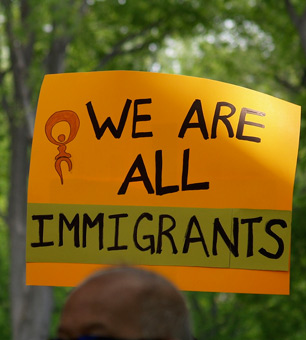SB90, passed in Colorado in 2006, might be long forgotten, but immigrants in the state continue to deal with its risks daily. Under the legislation, law enforcement is required to report anyone they arrest and suspect may be undocumented to Immigration and Customs Enforcement (ICE).
Now, rolling through Denver, the “No Papers No Fear Ride for Justice” bus full of undocumented and out activists is seeking to bring the forgotten immigration struggles like those in Denver back into the public eye before the November election.
With the human rights group Puente, based out of Phoenix, Arizona, the undocumented immigrants on the bus will be driving from Arizona to the Democratic National Convention in North Carolina. The three-dozen-strong group will also stop in New Mexico, Colorado, Texas, Louisiana, Alabama, Georgia and Tennessee.
“Our rights and our families are under attack and we’ve come too far to go back now. Undocumented riders will come out publicly, support local people to build barrio defense and perform peaceful civil disobedience to challenge the promoters of hate and set an example of love and fearlessness,” says the group’s web site.
The immigrant bus riders are just the latest strand of the ever-evolving movement that was started in 2009 in response to a growing number of undocumented youth coming of age in a country in which they had been raised, but did not have the right to work or attend school.
Arizona’s restrictive SB1070 immigrant law galvanized the activism, and “coming out” became increasingly used as a strategy to challenge immigration authorities by bringing out into the public what was otherwise seen as a secret to keep – immigration status.
The first piece of legislation that activists pushed for was the DREAM Act, which would have given a path to legalization for those brought to the country without papers as minors. Despite numerous sit-ins at which DREAMers risked arrest, the legislation was ultimately put forward as an either/or option with don’t ask, don’t tell and didn’t pass.
Meanwhile, Arizona’s SB1070 was introduced in the legislature, and in the years following, both Georgia and Alabama introduced equal or harsher measures against immigrants.
President Barack Obama campaigned on immigration reform, promising to enact a plan in his first year in office. Instead, he has deported more people than George Bush and expanded the Secure Communities program.
Fernando Lopez, 21, riding on the “Undocubus,” was stopped by ICE for a traffic violation in 2011. He spent a month in a detention center in Phoenix before friends and family were able to bring together money to bail him out.
Now, he says, he is riding with others, “saying they don’t have fear even though they don’t have papers.”
In early 2012, the Obama administration announced that it would start a more widespread policy of using prosecutorial discretion to decide which immigrants should be deported. But the review of how ICE is dealing with the more than 300,000 pending removal cases by Immigration Impact found that “ICE is exercising prosecutorial discretion on an increasingly infrequent basis.”
Then, in June 2012, came the deferred action pathway for DREAMers, which would allow some undocumented people brought as children to get work permits. However, it would not change their immigration status and there is still widespread confusion as to how this will work.
Against this background of broken promises and with the history of the first Freedom Riders during the civil rights era, the “No Papers No Fear Ride for Justice” bus will make its way to the Democratic National Convention.
Our most important fundraising appeal of the year
December is the most critical time of year for Truthout, because our nonprofit news is funded almost entirely by individual donations from readers like you. So before you navigate away, we ask that you take just a second to support Truthout with a tax-deductible donation.
This year is a little different. We are up against a far-reaching, wide-scale attack on press freedom coming from the Trump administration. 2025 was a year of frightening censorship, news industry corporate consolidation, and worsening financial conditions for progressive nonprofits across the board.
We can only resist Trump’s agenda by cultivating a strong base of support. The right-wing mediasphere is funded comfortably by billionaire owners and venture capitalist philanthropists. At Truthout, we have you.
We’ve set an ambitious target for our year-end campaign — a goal of $205,000 to keep up our fight against authoritarianism in 2026. Please take a meaningful action in this fight: make a one-time or monthly donation to Truthout before December 31. If you have the means, please dig deep.
